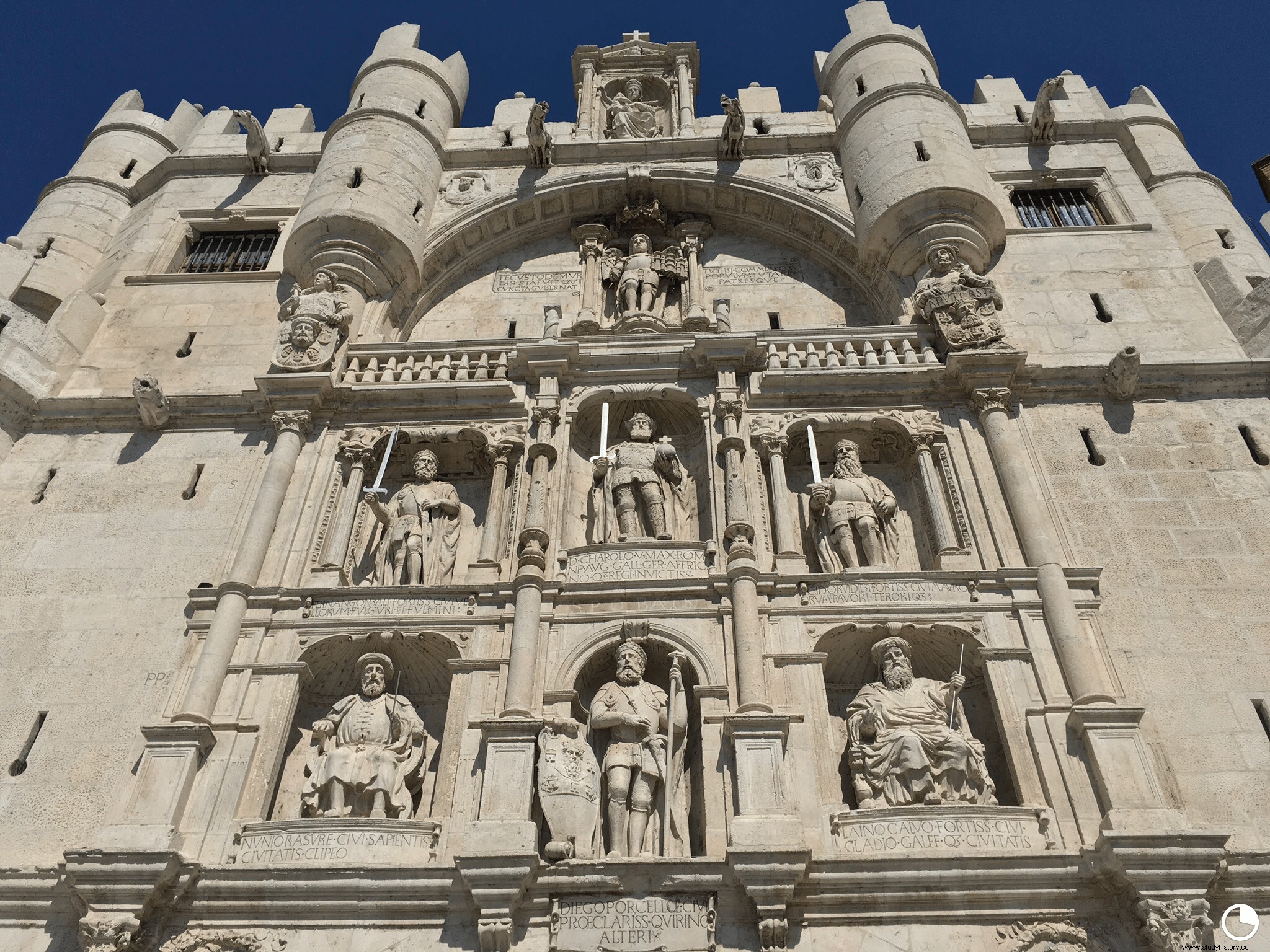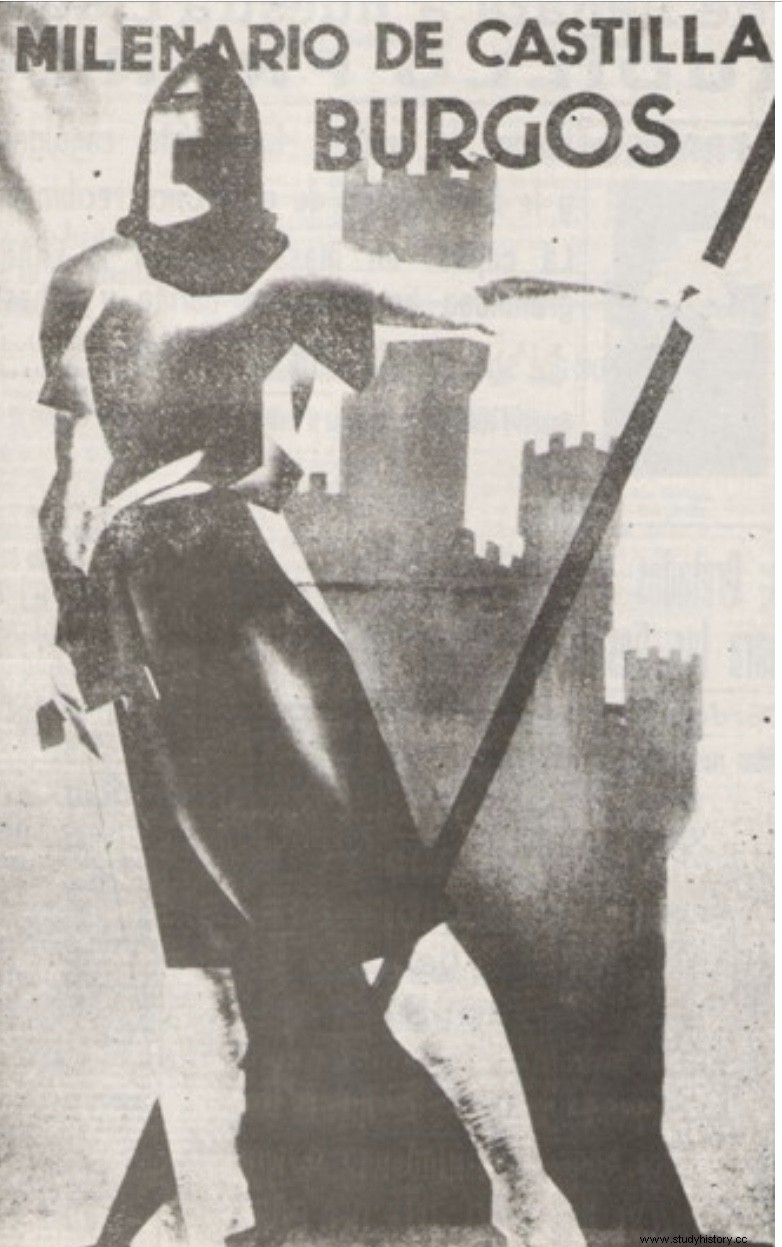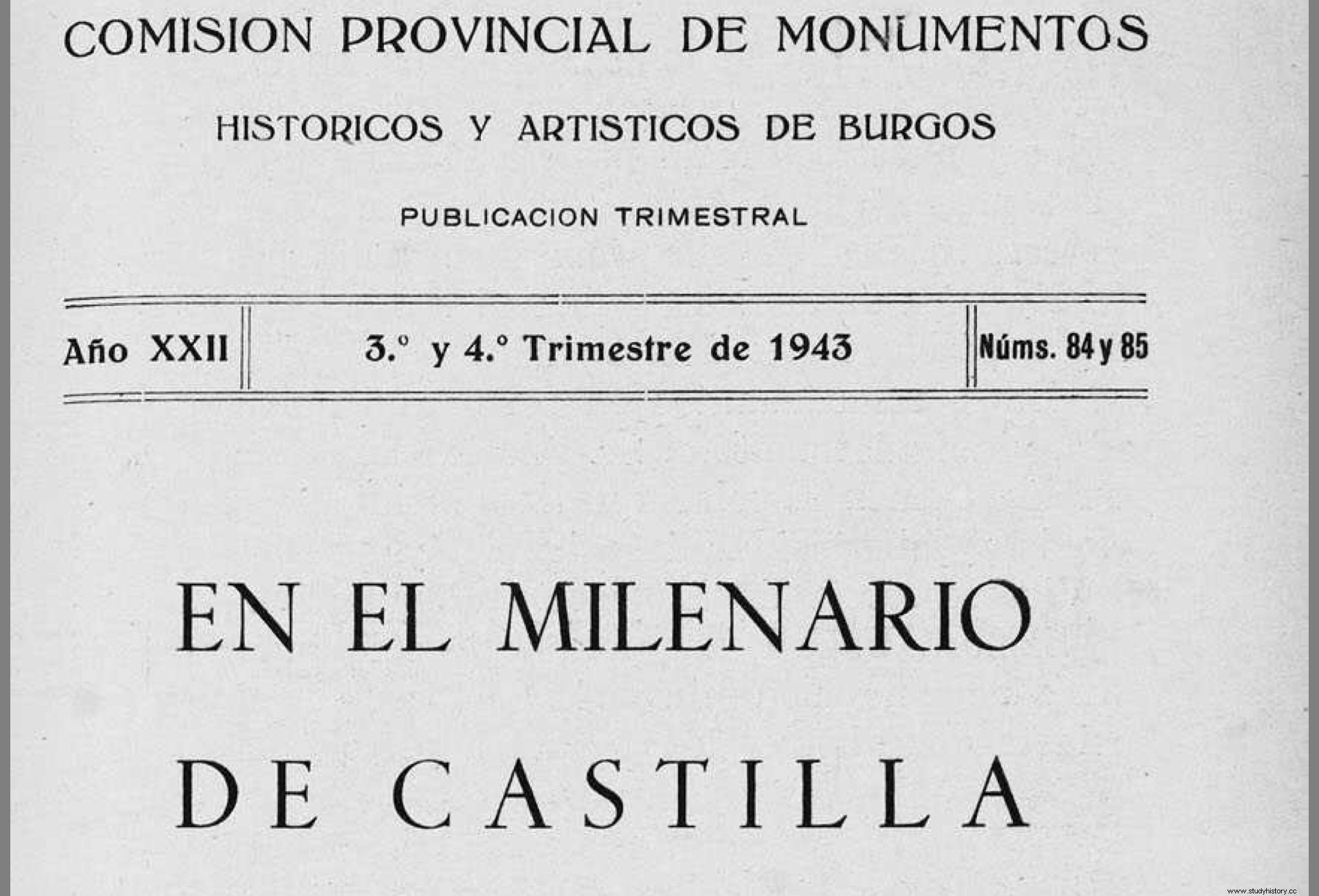I continue this article where I left off in the previous entry:the myth of the independence of the county of Castile (I)
2.- Appropriation of the myth by the historiography of the 19th century and the beginning of the 20th
The supposed Castilian independence served as a great loudspeaker and the historiographical propaganda of the Spanish 19th century turned it into a myth, a liberal historiography, in the words of Altés Domínguez "that emerged in the 19th century linked to the establishment of the European Nation-States[...] . Its main characteristic is its nationalist perspective» and it would end after the disaster of 1898 by constructing the story of the independence of Castile as an essential element of Spanish nationalism.
The first significant milestone is the History of Spain by Modesto Lafuente (1850), from which almost all the authors of the 19th century will drink and who writes about it:
«We, sticking to the historical data, cannot anticipate it (the independence of Castile) in the middle of the 10th century and at the time when we see the illustrious count already acting on his own and without subjection to the kings of León, rather launching that throne to the recognized monarch and placing in his place, even without right, a relative of his. We will not point out the precise day on which Castile was able to call itself independent because there was no day of solemn proclamation, nor do we read anywhere that banners were raised on certain days in public squares shouting “Castilla for Count Fernán González!” Castile and the count of her were slowly gaining independence ».

Other 19th-century authors, also along the lines of liberalism or belonging to an anti-liberal, neo-Catholic and traditionalist current that emerged after the Democratic Sexenio, refer to the independence of Castile with nuances about the existence or not of Castilian judges and even about the assessment of independence itself, which is not always positive, but in any case taking for granted that Fernán González was the count who achieved the independence of Castile. What is more important is that they do not give the fact any ideological nuance in relation, above all, to the confrontation between Castilla and León.
Things would change with the disaster of 1998 and the first years of the 20th century, with a discourse that had already begun to emerge a few years earlier with Joaquín Costa. This is how Altés Domínguez explains it:
«A new language around Castile was born at the beginning of the 20th century and would be installed for decades in the Spanish intellectual imaginary. Castile is no longer just an old medieval peninsular kingdom, not even the most important of them all, but much more. It is the very essence of Hispanism, with a libertarian and egalitarian spirit [...]. In short, it is a discourse that, due to its exaltation of rebellion against tyranny, democracy against authoritarian hierarchy and equality, could only emerge in a liberal climate among liberal authors."
This identification of Castile, of the relevance of its independence as the motor of the Spanish spirit, and its confrontation with León, as it could not be otherwise in the case of an essentially liberal current, was destined to collide with the ideas of the regime that emerged after the Civil War. Civil.
3.- Updating the myth during the Franco regime:the “Millennium” of Castile in 1943
The discourse on the independence of Castile was updated and modified, for different reasons, by the Franco regime. Obviously, after the Civil War neither the liberal tone nor the independence discourse could be the order of the day in the new Spain. Altés expresses it graphically:«in a moment immediately after a civil war, in which the winning side tries to project an image of unity through its propaganda, a myth about an independent count who rises up against his king and manages to liberate his people turns out to be uncomfortable.”
The first speculations on how to reinvent the myth of Castile for the benefit of the Franco regime come from the Falangist sector and correspond to authors such as Antonio Tovar or Víctor de la Serna. This is how Crespo Redondo explains it:
«According to De la Serna, Castile through arms had defeated "the foreign and feminine". To celebrate it, it was appropriate to remember "the epiphany" of the region between 930 and 940. To this end, he addressed the Ministers of Foreign Affairs, National Education and the Interior and, before the end of the war, encouraged them to "show the world with most solemn acts the wonders of a thousand-year-old young people”. […]. From the founding years, the Falangists believed that Castile had united the Spanish nation and promoted its imperial expansion, being able in both companies to renounce their own interests in favor of superior ideals. In 1938, when the war was about to end, paying homage to Castilla "young" after a thousand years, in the words of Víctor de la Serna, was for the Falangists a call to unity, forgetting particularisms and the integration of the Spanish in a project common cause of national resurgence”.
Following Altés Domínguez again, we see how some school books of the regime contain a «synthesis between the Castilianist discourse of the liberal tradition, which sees Castile as "mother of Spain" and the national-Catholic discourse that ponders the "empire for the Cross" as national characteristic and that seeks to legitimize Franco's authority, evoking here the "caudillo" figure of the counts of Castile».
 Even following De la Serna's recommendations, the supposed thousand-year anniversary was celebrated with great pomp since the independence of the county in Burgos in 1943 with the presence of Franco himself in some of the scheduled events. Crespo Redondo explains it this way:«For the national and local authorities, the official objective of all these acts was to celebrate, a thousand years later, the independence of the County of Castile, presumably achieved in 943 by Count Fernán González when he rebelled against his lord, the king of León, Ramiro II. In reality, the government used the commemoration of that supposed historical event for its own political benefit, to socially reinforce the image of the Regime, bring together the different political forces that made it up and, above all, to exalt the figure of Franco and legitimize the Civil War».
Even following De la Serna's recommendations, the supposed thousand-year anniversary was celebrated with great pomp since the independence of the county in Burgos in 1943 with the presence of Franco himself in some of the scheduled events. Crespo Redondo explains it this way:«For the national and local authorities, the official objective of all these acts was to celebrate, a thousand years later, the independence of the County of Castile, presumably achieved in 943 by Count Fernán González when he rebelled against his lord, the king of León, Ramiro II. In reality, the government used the commemoration of that supposed historical event for its own political benefit, to socially reinforce the image of the Regime, bring together the different political forces that made it up and, above all, to exalt the figure of Franco and legitimize the Civil War».
Crespo Redondo's article cited among the sources of this entry contains a detailed and very interesting account of the festivities celebrated in Burgos in 1943, containing such funny details as the exclusion of León from among the invited provinces (let's say he was the villain of the film) at the same time that the unruly Vizcaya and Álava were invited to remind them of their ancient ties with Castile. Also very interesting is the fear (unfounded at the end) caused by the speech that the old professor Ramón Menéndez Pidal was to give, not very much in favor of some of the theories sponsored by the organizers.
As a curious fact, in response to this "celebration", a group of Spanish exiles in London got the BBC to broadcast a series of 23 programs dedicated to Castile in which the official thesis of Francoism was refuted. Personalities such as Claudio Sánchez Albornoz, Tomás Navarro Tomás, Pedro Salinas, José Castillejo, Pío del Río Hortega, Ramón Gómez de la Serna, Salvador de Madariaga, Luis Cernuda or professors from British universities, such as J.B. Trend, G.R.H. Weaver and Walter Starkie.
Celebrating this anniversary in 1943 was chosen arbitrarily (in fact, it was initially planned as an almost local event in Burgos that was going to take place in 1942, but the regime's propaganda appropriated the idea and gave it a much more political and national character. ). Crespo Redondo explains the cause of this inconsistency:«Neither organizers nor interveners thought of the historical past as an object of study but as a means of political propaganda. That is why the Government, instead of entrusting the project to the Royal Academy of History, entrusted it to a political body, the National Propaganda Delegation, which depended on the Vice-Secretariat of Popular Education of the General Secretary of F.E.T. and of the JONS».

4.- Known historical facts
As a historical fact, what is known is that the counts of Castile, Fernán González, and of Saldaña, Diego Muñoz, disappeared for a few months (between February and May 944 as the initial date and April 945 as the final date) from the mentions documentaries as such dignitaries. It seems that both counts rebelled against Ramiro II. The reasons are not very clear; the apparent cause put forward by some was the delivery to the Count of Monzón of the lands between the Cea and Pisuerga rivers, but it does not seem that this was the case since these lands already belonged to the county of Saldaña, not Monzón. Other sources point out as the cause of the disagreement the construction by Fernán González of a formidable defensive tower in Covarrubias without previously requesting the mandatory permission of the monarch to do so.
Whatever the reason, the truth is that the king defeated them and imprisoned them, handing over their domains to the aforementioned Count of Monzón. But the disagreement should not have lasted long, because a year later they regained their freedom and swore allegiance to the king, reaching the conclusion and consummation of the marriage of the king's son (Ordoño) with the count's daughter (Urraca). Surely Ramiro was aware that with the threat of the caliphate he could not afford to do without two figures such as the counts of Castilla and Saldaña. What he did do was assign another of his sons to the Castilian territory to intervene in the government (the future Sancho I).
In any case, this incident was a warning of the importance that the county of Castile was taking on, which would be reproduced more successfully in the following reigns, although, as we have said, at no time did an express declaration of independence of the county of Castile take place. Castile with respect to the kingdom of León, neither during the condal mandate of Fernán González, nor during that of his son García Fernández (970-995).
The fact that the county was inherited by his son demonstrates the degree of strength that Castile reached under the rule of Fernán González, which breaks the tradition that the Count of Castile is designated by the King of León and manages to make him hereditary for his family, which will rule Castile for the next almost sixty years. This does not mean, we reiterate, that Castile was independent of León. In fact, in the first document signed by García as Count of Castile, his name is preceded by «rex Radimiro in Legione». This would be a constant throughout his rule as Count of Castile.
Nor during the time of his son, Sancho García (995-1017) did Castilla de León become independent, and much less during that of his son, García Sánchez (1017-1028), who was only a child when he inherited the county and who was under the direction of his brother-in-law Sancho III el Mayor, king of Pamplona.
Nor did the successor of García Sánchez, the future Fernando I of León, make the county independent before or after obtaining the crown of León in 1038. It would be on his death in 1065 that he divided his domains among his three sons, Alfonso (whom he gave León), García (to whom he granted Galicia) and Sancho, when he became monarch of an already independent Castile, but not as a county, but as a kingdom. Independence that would not be definitive... but that is another story.
I do not want to end without commenting on the opinion of various authors on this supposed independence from Castile. Carvajal Castro succinctly defines the relationship between the king of León and this county:"in Castile the king was a symbolically present figure, but distant in practical terms."
In the words of the Condado de Castilla page:
«It is common to read, even in current historical works, that Count Fernán González is responsible for the independence of Castile from the kingdom of León, the first independent count of Castile. There is even a legend, which is told for the first time in El Poema de Fernán González about the loan of a horse and a goshawk to the king of León for so long that, when the king was forced to repay the interest, he found that the best thing was that Fernán González had absolute control of Castile.
The reality is that the county of Castile was never independent and always belonged to the kingdom of León. What is certain is that Fernán González managed to unify in a single demarcation and under a single power a set of territories that until 931 were fragmented and that, from that moment, will always make up Castile. In addition, by participating in the different conflicts surrounding the Leonese kings, he acquired great power and became the arbiter of Leonese politics and its strong man. This is how he […] he established a hereditary line in the county of Castilla that lasted until count García Sánchez.
In conclusion, with Fernán González, Castilla appears as a well-defined political entity, expanding and with the capacity to decisively influence the power struggles that take place in León and to successfully oppose the Cordovan incursions on the border. But it was by no means independent of the kingdom of León."
In the same sense, Martínez Díez, after an exhaustive study of the forty years of Fernán González's government, concludes:«nowhere have we found a single historical testimony that attests to that presumed independence and segregation of the Leonese monarchy. At most, some attitudes of factual rebellion or some attempt to proceed according to their own personal interests, attitudes and attempts not very different from those adopted by the great Galician counts or other magnates of the same monarchy, to those who That no one has therefore qualified as independent counts or sovereigns.”
Gonzalo Martinez Diez. The county of Castile (711-1038). History versus legend (I) Marcial Pons Editions of History. 2005.
Andres Altes Dominguez. The independence of the county of Castile. Genesis and significance of a myth (19th-21st centuries). Editions of the Ergastula. Madrid 2017.
County of Castilla:https://www.condadodecastilla.es/personajes/fernan-gonzalez/
Jesus Crespo Redondo. Castile turns a thousand years old. History and politics in the commemoration of the millennium of Castilla 1943 . Dialnet.
